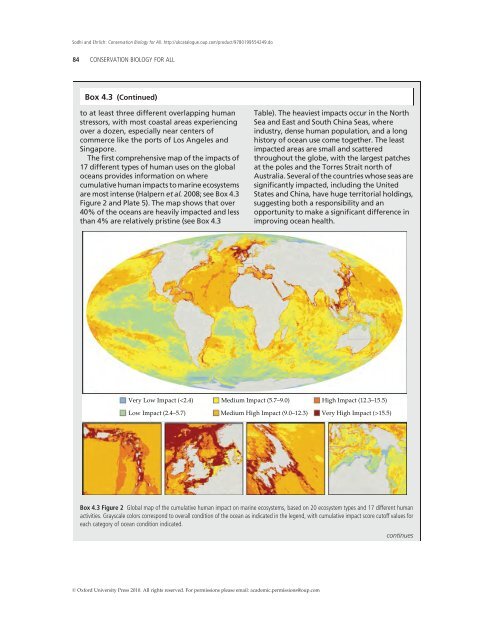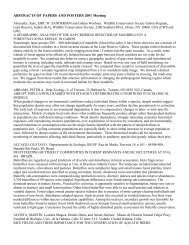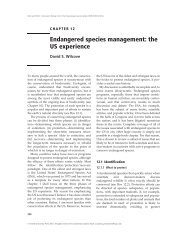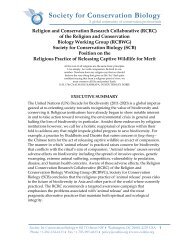Habitat Destruction: Death by a Thousand Cuts - Society for ...
Habitat Destruction: Death by a Thousand Cuts - Society for ...
Habitat Destruction: Death by a Thousand Cuts - Society for ...
- No tags were found...
You also want an ePaper? Increase the reach of your titles
YUMPU automatically turns print PDFs into web optimized ePapers that Google loves.
Sodhi and Ehrlich: Conservation Biology <strong>for</strong> All. http://ukcatalogue.oup.com/product/9780199554249.do<br />
84 CONSERVATION BIOLOGY FOR ALL<br />
Box 4.3 (Continued)<br />
to at least three different overlapping human<br />
stressors, with most coastal areas experiencing<br />
over a dozen, especially near centers of<br />
commerce like the ports of Los Angeles and<br />
Singapore.<br />
The first comprehensive map of the impacts of<br />
17 different types of human uses on the global<br />
oceans provides in<strong>for</strong>mation on where<br />
cumulative human impacts to marine ecosystems<br />
are most intense (Halpern et al. 2008; see Box 4.3<br />
Figure 2 and Plate 5). The map shows that over<br />
40% of the oceans are heavily impacted and less<br />
than 4% are relatively pristine (see Box 4.3<br />
Table). The heaviest impacts occur in the North<br />
Sea and East and South China Seas, where<br />
industry, dense human population, and a long<br />
history of ocean use come together. The least<br />
impacted areas are small and scattered<br />
throughout the globe, with the largest patches<br />
at the poles and the Torres Strait north of<br />
Australia. Several of the countries whose seas are<br />
significantly impacted, including the United<br />
States and China, have huge territorial holdings,<br />
suggesting both a responsibility and an<br />
opportunity to make a significant difference in<br />
improving ocean health.<br />
Very Low Impact (15.5)<br />
Box 4.3 Figure 2 Global map of the cumulative human impact on marine ecosystems, based on 20 ecosystem types and 17 different human<br />
activities. Grayscale colors correspond to overall condition of the ocean as indicated in the legend, with cumulative impact score cutoff values <strong>for</strong><br />
each category of ocean condition indicated.<br />
continues<br />
© Ox<strong>for</strong>d University Press 2010. All rights reserved. For permissions please email: academic.permissions@oup.com






